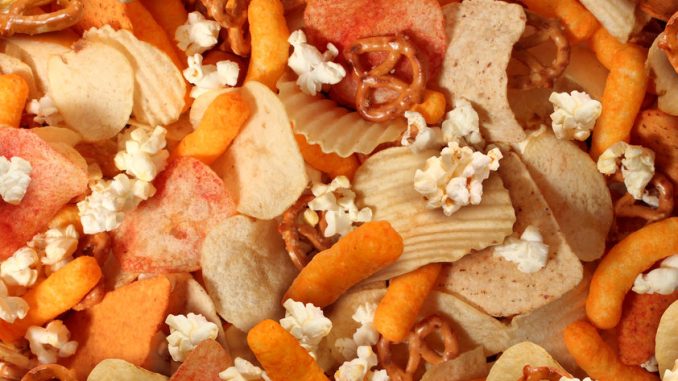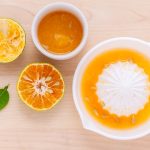
Extrusion is a relatively modern food processing technology but has found traction in a number of food manufacturing operations, mainly snacks. It is essentially a continuous cooking, forming and mixing process. The materials that are extruded are usually cereals, grits, flour, proteins and even whole grains.
What is an extruder ?
The industry relies on two types of screw extruder although there are other types that are distinctly related. Generally, a screw extruder is a helical shaft within a cylindrical barrel that is closed at one end by a die plate with holes of assorted shapes cut or drilled into it. The shaft or screw is rotated by an electric motor and the barrel may be jacketed or not. Various sections along the shaft can be heated or cooled.
A single-screw extruder is simply a single shaft within a lone barrel. More complicated devices such as the twin-screw extruders have two shafts usually inside a double barrel which gives them a figure of eight appearance viewed end on. These two screws can intermesh or remain apart with rotation in both or opposite directions.
A feed hopper with a metering device to monitor input and control feed is always required. Preconditioner units can be added which are other cylinders with a conveying screw where the feed materials in partially cooked and hydrated before being fed to the extruder proper.
The die plate very often has inserts with the exact cross-sectional shape required and incorporated into the inserts. It means that inserts can be altered and replaced depending on the required shape of the product desired.
The extruder is a very advanced mixer, heat exchanger, pump and former which incorporates a number of unit operations into one. Using a combination of heat and steam or moisture generally, carbohydrates in the cereal grains for example rapidly swell, gelatinize or just hydrate to create various doughs and pastes in various states. Proteins can simply denature and solubilise to form intricate structures with varying viscosities.
History Of Extrusion
Extrusion was being first attempted in the 1930s by large corporations such as General Mills. In 1964, Anelly describes a process for producing spongy elastic particles made from soy flour. Six years later, Atkinson in 1970 describes a continuous cooking process based on extrusion. The first breakfast cereal products were produced in 1981.
Developments continued in 1998 with the extrusion of high moisture protein foods and then in 2000 fast describes in a patent the production of RTE cereals.
In 2011 extrusion is used to destroy aflatoxins and in the same year, an oat-based cereal snack is produced.
A variety of applications are described in a sister article on various extruded foods.
The Issues Associated With Single-Screw Extruders Compared To Twin-Screw Extruders
Single-screw extruders are commonly found in the food industry. There are a number of features which characterise them when compared to twin-screw extruders. For a start they have a lower output which means that the cost of production of any product is higher. The rate of production is also fixed because the RPM level is a constant during manufacturing however this figure can be optimised for the specific product being created.
Another key aspect is that the L/D ratio is a limitation. [The L/D ratio refers to the length to diameter ratio]. The value is limited to a ratio between 24 and 32.
Any mixing during extrusion occurs through application of friction and back pressure. Most single-screw extruders operate using frictional (mechanical) forces which have the consequence of producing more degradation than is required. Another issue to contend with is non-homogeneity in the extruded products which produces limitations in quality.
The residence time is higher. This also produces more degradation in the product which requires more doses of stabiliser to be added to the feedstock.
The Benefits Of Twin-Screw Extruders
Single-screw extruders have a number of disadvantages earlier described. These issues led to development of twin-screw extrusion. One of the main benefits was the use of intermeshing screws encased in a matching barrel. In this instance the double-barrel system works like a positive displacement pump which is now independent of frictional forces. On this basis the twin-screw extruders are like gear pumps.
What are the chemical changes that take place during extrusion ?
The extrusion process generally involves a number and variety of chemical and structural transformations which produce a range of different and in some cases unique products that had previously not been seen before in foodstuffs. The various chemical changes occurring include the gelatinization and melting of starch, various forms of denaturation or cross-linking of proteins into a number of formats, loss of vitamins and pigments and the formation of complex lipids. Not all those changes are thus positive so a careful balancing act based on a full understanding of the processes is required.
Maillard reactions are the predominant changes occurring between proteins and sugars in the extrusion cook. These are favoured by the relatively high temperatures and low water content that are observed in the process. The Maillard reactions lead to losses not just of amino-acids but also reducing sugars with which they react, pigments and vitamins as mentioned before. The changes to proteins generically include peptide bond cleavage, oxidation, deamidation (removal of amino groups), racemization and beta-elimination. The amino-acids most prone to alteration are essential ones like tryptophan, cysteine and lysine (Björck et al., 1983).
The quality of the extruded food is determined by the various chemical and physical transformations that manifest themselves in the barrel. A knowledge of the various kinetic parameters based on food models is essential to determining how a food will behave during extrusion. Measurement with a good degree of accuracy of all the kinetic parameters such as the rate constants, activation energy, etc. are needed to predict many of the quality changes during food processing.
Chemical changes during extrusion cooking are influenced by the form and intensity of thermal and shear energy inputs. The most important difference between extrusion and conventional cooking processes is the additional intensive shear forces that occur in the extruder. Kinetic parameters from conventional heat treatment processes cannot be used unconditionally in extrusion cooking.
Most of the extrusion cooking processes have a residence time ranging from 10 to 120 seconds. The variability in residence time increases the importance of kinetic investigations in extrusion cooking.
The Role Of Extrusion Forces
Specific Mechanical Energy
The specific mechanical energy (SME) is the mechanical work from the motor that is converted into heat accumulating in the feed mixture (Godavarti & Karwe, 1997).
The higher the SME, the more heat generated as extrusion proceeds. The value is one of the most important in terms of what it does to the extrudate. It affects virtually all the physicochemical qualities such as puffing or expansion, water solubility, extrudate density and texture (Fang et al., 2014).
The level of SME also impacts degradation and the chemical transformation of ingredients. There is a positive correlation between SME and screw speed. The highest SME is obtained with screw speeds in the range of 100 rpm to 300 rpm. In foods, there are always exceptions to this rule but the experience holds up.
Increasing temperature reduces the input of mechanical energy due to a drop in melt viscosity. A greater feed moisture also reduces melt viscosity so a lower SME is expected (Altan et al., 2008; Duarte et al., 2009).
Physical And Material Properties During Extrusion
The flow of the materials through the barrel represents an essential part of the transforming process. Never has rheology been such an important physical attribute yet it still remains a mystery in part when it comes to extrusion. All these materials behave like non-Newtonian liquids. It is probably easier to visualise the changes to foods as one does for polymers.
Within the barrel there is a complex mix of temperatures, shear rates and pressures which change as the feedstock modifies itself through the extruder. Most descriptions are best worked out as polymers, and thermoplastic ones at that.
A thermoplastic polymer gets thinner and softer and more malleable as it gets hotter. It becomes less viscous with increasing force or shear. The converse are the thermosetting polymers which behave in exactly the opposite manner. They become thicker and more viscous as temperature increases or even when shear and force is applied.
Carbohydrates such as wet corn grits are thermoplastic and ‘melt’ when they heated so becoming less viscous. Proteins like moist soy meal act like thermosetting polymers becoming thicker and more viscous as they are heated.
The typical parameters for a corn grit extrusion cover initial moisture content which on a dry basis is about 180 g/kg. The sorts of measures examined are bulk density, solid density, measures of expansion and the total, open and closed pore volumes of the final product.
Mixtures are commonly found in extrusion and can involve both types – thermosetting and thermoplastic. They are commonly pet foods and fortified porridges. Many snacks and breakfast cereals are based on a single major ingredient, such as corn or rice.
As these strangely behaving doughs or pastes are transported through the barrel by the screw’s rotation, they are heated by friction, at least, but may also be heated by direct steam injection and by heat transfer through the barrel wall and through a hollow screw in some cases. To control temperature, cooling may be applied through the barrel and screw.
Often, the objective is to thoroughly cook the mixture to make it soluble, digestible, and safe from pathogens. Temperatures may exceed the boiling point of water at atmospheric pressure because of pressure increase in the barrel. Shear forces may increase temperature and contribute in their own way to modifying properties of the material.
To increase shear, there can be sections of the screw that simply knead the material without attempting to transport it. To allow for such sections, many screws are modular, composed of short sections that can have different screw profiles, including reverse sections that contribute to back mixing. Screws typically are deeper and have a wider pitch—the distance between flights—at the feed end of the barrel because the bulk density of the feed material is typically lower than it is after it has been heated and compressed. Screw design is an empirical art. Any given machine usually has a selection of screw modules that can be assembled in various configurations to achieve the desired effects.
Over the various years, various models for assessing the shear rates and stresses of cooking on each type of product have been examined especially when it comes to reaction kinetics. Early studies in the eighties and nineties looked at shear stress generally (Davidson et al., 1984; Wang et al., 1992; Cai and Diosady, 1993) and there are a number of references to more specific aspects of the extrusion process such as starch conversion (Bhattacharya and Hanna 1987; Zheng and Wang, 1994; Yam et al., 1994; Gogoi et al., 1995; Ibanoglu and Ainsworth 1997), starch degradation (Diosady et al., 1985; Cai et al., 1995), wheat proteins degradation and polymerization (Strecker et al., 1995), vitamins degradation (Guzman-Tello and Cheftel, 1987).
Pumping Characteristics
Most screw extruders are comparable in performance to conventional pumps. Analogies between the two types are possible. Thus a single-screw extruder acts like a centrifugal pump in performance whilst the twin version operates more like a positive displacement pump.
Centrifugal pumps as with all pump types have a characteristic performance curve for a certain basic design that generally shows output pressure decreasing as flow-rate increases. Centrifugal pumps operate against a closed output line or dead head. The pressure generated under these conditions is always the maximum possible. When a centrifugal pump delivers against low resistance, then ‘nothing’ is connected to it and it can deliver the maximum flow-rate. Between these two extreme points, there is a unique set of points, characteristic of the pump’s specific design.
A positive displacement pump is not sensitive to the pressure against which it delivers, so its characteristic curve is a horizontal line of pressure against flow-rate. It will thus deliver whatever pressure is required up to some limit for any flow rate it handles. The limits are set by other features of the system such as the pressure of the seals, the gaskets or piping connections. A positive displacement pump must be protected against a dead head by having a relief valve or bypass loop present.
The pump actually acts against the die plate which is the main form of resistance. The pressure needed to move a fluid through a small hole is proportional to the apparent viscosity of the fluid, the length of the hole or thickness of the plate, the flow rate and the cross-sectional area of the hole.
On a plot of pressure against flow rate, this produces a generally straight line with a positive slope. The line increases as the flow-rate increases with all other factors being equal. This lien corresponds to the pressure drop against the flow-rate curve of a piping valve system to which a pump may be connected.
With a single-screw, the performance curve and the die plate line are plotted on the same graph. The lines will intersect at one point which is the operating point for this type of extruder. Any change that causes deviation from this point may upset the operation. One of the most sensitive changes is that of apparent viscosity which is not easy to define. For most foods, the operating point is sensitive to the moisture content so it is important to maintain this at a constant value when food material is fed to the extruder. This is the reason for the preconditioner.
Single-screw extruders are usually flood fed which means they are kept as full as possible. The flow-rate is controlled by adjusting the rotational speed. The most reliable scale-up parameter is the specific mechanical energy, so long as geometric similarity is maintained. So for example, the length divided by diameter is constant when the diameter increases so that screw design always remains constant.
Twin-screw extruders were developed for polymer processing especially in the handling of low viscosity polymers such as polyvinyl chloride. Intermeshing screws can grip elusive feed materials whereas a single-screw relies on processing a more sticky feed. Twin screws that are not intermeshing operate like two single-screws that appear to share the same barrel. Twin-screw extruders do not operate full, but rather flow-rate is determined by controlling feed rate. Whatever pressure is need to flow through a given die plate will be developed, within the limits of the gaskets and fittings.
One feature of the twin-screw extruder which is not more fully exploited is its potential ability to handle drier feed stocks which means greater economies when removing water that accompany extrusion processes.
Cooking extruder cause expansion of the material upon exiting the die as pressure is released and superheated water flashes into steam. This makes die design one of the more challenging elements of extrusion because non-Newtonian fluids may relive strain in ways that distort the shape in addition to the expansion.
Die Pressure And Torque
Die pressure is the work required to overcome the resistance of the feed mixture when at the extruder barrel die. The torque quantifies the force required by the screw to rotate and move the feed material out of the die. It can be expressed as a percentage (%). It compares the actual and permissible torque and is treated as a safety indicator of the extrusion process (Guha et al., 1997).
Energy Benefits And Effects.
Extrusion is relatively energy efficient. The food mixture is added at a low moisture level whilst cooking the product, so less re-drying is needed.
References
, , & (2008b). Evaluation of snack foods from barley–tomato pomace blends by extrusion processing. Journal of Food Engineering, 84, pp. 231–242 (Article).
Bhattacharya, M., Hanna, M.A. (1987). Kinetics of starch gelatinization during extrusion cooking. J. Food Sci. 52: pp. 764–6 (Article).
Björck, I,, Noguchi, A., Asp, N.G., Cheftel, J.C., Dahlqvist, A. (1983) Protein nutritional value of a biscuit processed by extrusion cooking: Effects on available lysine. J. Agric. Food Chem. 31: pp. 488–492.
Cai, W., Diosady, L.L. (1993). Model for gelatinization of wheat starch in a twin-screw extruder. J Food Sci. 58: pp. 872–6.
Cai, W., Diosady, L.L. Rubin, L.J. (1995). Degradation of wheat starch in a twin-screw extruder. J Food Eng. 26 pp. 289–300.
Davidson, V.J., Paton, D., Diosady, L.L., Rubin, L.J. (1984). A model for mechanical degradation of wheat starch in a single-screw extruder. J. Food Sci. 49 pp. 1154–7.
Ding, Q. B., Ainsworth, P., Tucker, G., & Marson, H. (2005). The effect of extrusion conditions on the physicochemical properties and sensory characteristics of rice-based expanded snacks. J. Food Engineering, 66(3), pp. 283-289.
Diosady, L.L., Paton, D., Rosen, N., Rubin, L.J., Athanassoulias, C. (1985). Degradation of wheat starch in a single-screw extruder: Mechanokinetic breakdown of cooked starch. J. Food Sci. 50 pp. 1697–9, 1706
, , & (2014). Effects of the specific mechanical energy on the physicochemical properties of texturized soy protein during high‐moisture extrusion cooking. Journal of Food Engineering, 121, pp. 32–38. https://doi.org/10.1016/j.jfoodeng.201 .
Gogoi, B.K., Wang, S.S., Yam, K.L. (1995). Applicability of a shear induced rate constant model to conversion of corn meal in a twin-screw extruder. J. Food Process Preserv. 19 pp. 53–63
, , & (1997). Twin‐screw extrusion of rice flour without a die: Effect of barrel temperature and screw speed on extrusion and extrudate characteristics. Journal of Food Engineering, 32, pp. 251–267. https://doi.org/10.1016/S0260-8774(97)00028-9
Guzman-Tello, R., Cheftel, J.C. (1987). Thiamine destruction during extrusion cooking as an indicator of the intensity of thermal processing. Int. J. Food Sci. Technol. 22 pp. 549–62.
Ibanoglu, S., Ainsworth, P. (1997) Kinetics of starch gelatinization during extrusion cooking of tarhana, a traditional turkish wheat flour-yogurt mixture. Int. J. Food Sci. Nutr. 48 pp. 201–4.
Strecker, T.D., Cavalieri, R.P., Zollars, R.L., Pomeranz, Y. (1995) Polymerization and mechanical degradation kinetics of gluten and glutenin at extruder melt-section temperature and shear rates. J. Food Sci. 60 pp. 532–7, 557.
Wang, S.S., Chiang, W.C., Zheng, X., Zhao, B., Cho, M.H. (1992). Application of an energy equivalent concept to the study of the kinetics of starch conversion during extrusion. In: KokiniJL, HoCT, Karwe, MV, editors; Food Extrusion Science and Technology. New York : Marcel Dekker. pp 165–76.



Leave a Reply